The Electronic Intifada 5 May 2025

A woman mourns over the body of a loved one killed in overnight Israeli strikes on northern Gaza at the Al Ahli Arab Hospital in Gaza City, 3 April.
APA imagesDuring the month of April, Israel pressed on with its deadly and destructive offensive in the occupied Gaza Strip, which has been under total blockade since 2 March.
More than 2,300 people have been killed in Gaza and nearly 6,000 injured since Israel broke the ceasefire on 18 March. More than 423,000 people have been displaced within Gaza Israel resumed its intensive attacks.
At least 52,400 people have been killed and 118,000 injured in Gaza since October 2023, according to the health ministry in the territory.
Meanwhile, in the occupied West Bank, at least 18 Palestinians were killed by Israeli forces during April. Between 1 January and 30 April 2025, at least 118 Palestinians were killed in the territory.
Between 7 October 2023 and 26 April, 924 Palestinians in the West Bank were killed.
Around 40,000 Palestinians remain displaced amid an ongoing Israeli offensive in the northern West Bank that began in January.

Children play on the third day of Eid al-Fitr in Nuseirat refugee camp, central Gaza Strip, 1 April.
APA imagesOn the first day of April, Hussam al-Loulou, a watchman at an urgent care unit run by Doctors Without Borders, was killed in an airstrike south of Deir al-Balah, central Gaza, along with his wife and 28-year-old daughter.
The medical charity said 11 members of its staff have been killed in Gaza since October 2023. More than 1,000 medical workers were killed in Gaza during that same period.
On 2 April, Israeli warplanes hit a health clinic belonging to UNRWA, the UN agency for Palestine refugees, in Jabaliya refugee camp in northern Gaza. The building had already been heavily damaged and was being used as a shelter for more than 700 displaced people.
Nine children, including a 2-week-old baby, were reported killed in the attack.
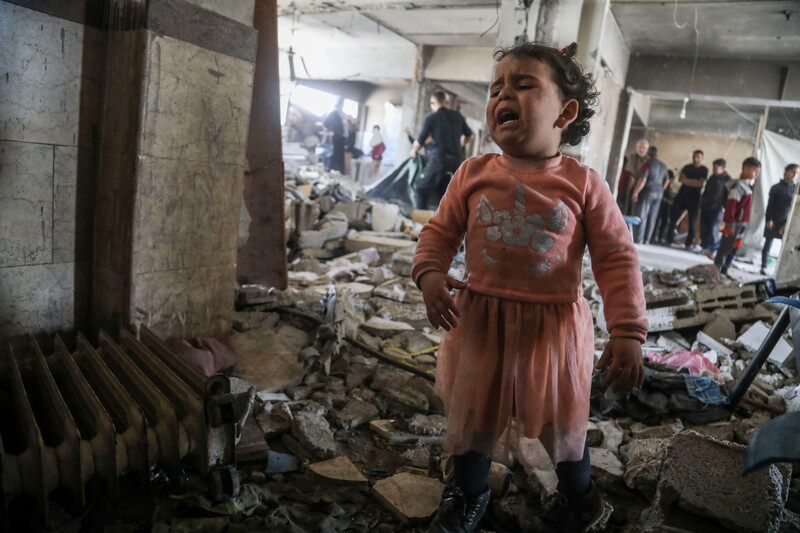
A Palestinian child cries inside a damaged UNRWA building after an Israeli strike that killed at least 19 people, including nine children, in Jabaliya refugee camp, northern Gaza, 2 April.
ActiveStillsSave the Children, a charity based in the UK, said on 2 April that around 130 babies are being born daily in Gaza, where the health care system is on “the verge of collapse.”
“The survival of mothers and newborn children in Gaza is under particular threat due to the lack of food, destruction of hospitals and chronic stress,” the charity stated.
At least 287 Palestinians were killed in Gaza between 3 and 8 April alone, according to the health ministry in the territory.
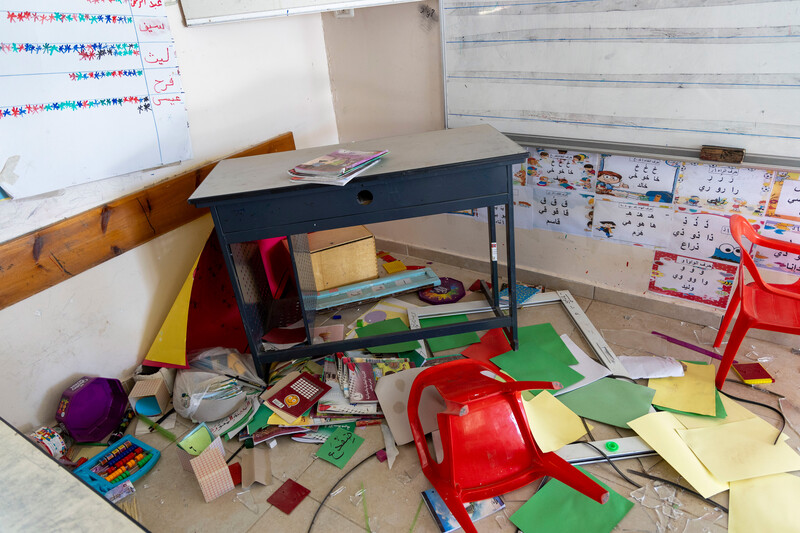
Damage is seen in a classroom of the local school in Jibna village following an attack days earlier by Israeli settlers and soldiers on the village located in the Masafer Yatta area in the southern West Bank, 3 April.
ActiveStillsThe UN Office for the Coordination of Humanitarian Affairs said on 3 April that 65 percent of Gaza’s territory was under Israeli forced displacement orders or had been declared “no go” zones.
“Nowhere is safe,” the UN office said.
Benjamin Netanyahu visited Hungary in defiance of an arrest warrant by the International Criminal Court in early April. On 3 April, during Netanyahu’s visit, Viktor Orbán, Hungary’s far-right prime minister, announced that his country would withdraw from the ICC, calling it a “political court.”
On 4 April, Reuters reported that the Trump administration in Washington had proceeded with the sale of 20,000 assault rifles to Israel. The sale was delayed by the Biden administration “over concerns they could be used by extremist Israeli settlers,” as Reuters stated.

A Palestinian family sits at the site of an Israeli strike that killed seven members of the Sharab family, including a child and three women, in Khan Younis, southern Gaza Strip, 3 April.
ActiveStillsOn 1 April, dozens of settlers broke into Duma village near Nablus in the northern West Bank and set fire to several vehicles, burned a chicken coop and sprayed graffiti on the walls of homes while raiding Israeli forces fired tear gas and live ammunition, injuring three people, according to the UN Office for the Coordination of Humanitarian Affairs (OCHA).
Palestinians in the West Bank are under increasing pressure from both settlers and the Israeli military.
On 6 April, Israeli forces demolished more than 33 structures, including 11 residential tents, and damaged water tanks and solar panels in Khirbet al-Ras al-Ahmar, located in an area of the West Bank’s Jordan Valley that Israel has designated as a firing zone.
The mass demolition incident displaced 33 people, including 19 children – all of whom were previously displaced from another area of the Jordan Valley due to settler violence, according to OCHA. The UN office said it was the “highest number of structures demolished in a single incident in the Jordan Valley since November 2020.”
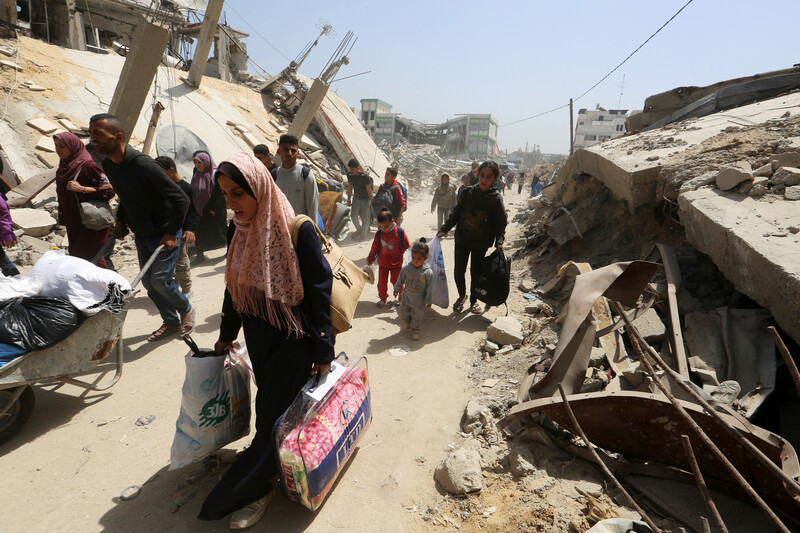
Families flee Shujaiya, east of Gaza City, following an evacuation order issued by the Israeli military on 3 April.
APA imagesAlso on 6 April, the UN human rights office stated that it was “alarmed by the breakdown of public order in Gaza, with recent allegations of killings and unnecessary or disproportionate use of force in crowd control by local police.”
The UN office added that Gaza’s governance and law enforcement structures have been dismantled and destroyed by Israel’s attacks, “contributing to a deterioration of public order that threatens the safety of Palestinians and their access to basic services and life-saving humanitarian aid.”
Also on 6 April, Hamas said it fired rockets from Gaza, with Israeli media reporting a direct strike in Ashkelon in southern Israel that lightly injured 12 people. Rockets were also fired from the territory on 3 April but were reportedly intercepted.
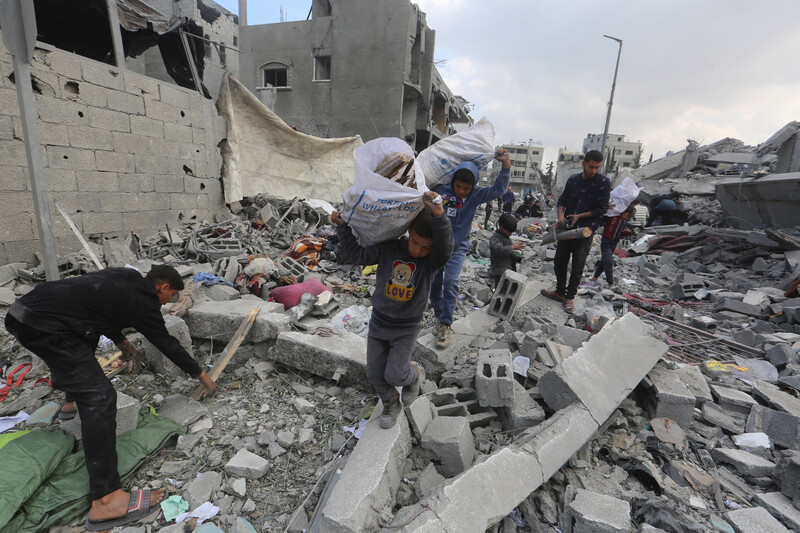
Palestinians salvage items in the devastated yard of a school a day after it was hit by an Israeli strike in the al-Tuffah neighborhood of Gaza City, 4 April. Gaza’s civil defense agency said that at least 31 people were killed in the attack on the school serving as a shelter for displaced people.
APA imagesThat same day, the Palestine Red Crescent Society announced that two of the humanitarian group’s administrators were killed in an attack on their home in Khan Younis, along with their three children.
On 7 April, three people were fatally injured in a direct Israeli attack on a tent used by journalists in Khan Younis, southern Gaza. Those killed were Helmi Mahmoud al-Faqawi, a reporter for Palestine Today news agency, and Yousef Khalil al-Khuzundar, 30, a volunteer assistant, and Rawhi Mansour, 35, a journalist. Several others were injured.
Photojournalist Hassan Islayeh was among those injured and set on fire during the attack. The Israeli military admitted to intentionally attacking the journalists and stated that Islayeh was their target, alleging without substantiation that he was an operative of an armed group.
More than 200 journalists and media workers have been killed in Gaza since October 2023, according to the Palestinian Journalists Syndicate.
“As part of the broader genocidal campaign it is carrying out in the Gaza Strip, Israel has killed at least 15 Palestinian journalists since the beginning of this year alone,” the Euro-Med Monitor stated on 7 April.
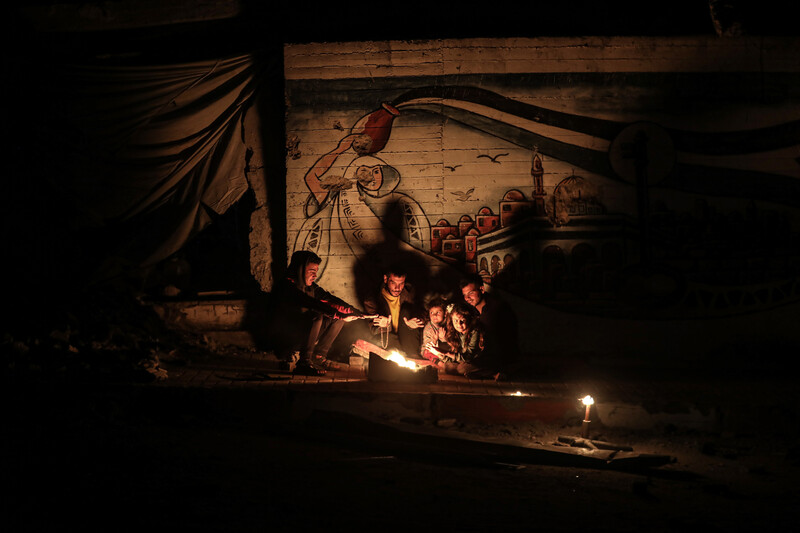
A displaced family sit by a fire in the Unknown Soldier Park in central Gaza City, 6 April.
APA imagesAlso on 7 April, seven Palestinians, including two children, were killed in an attack on a food charity distribution point in Khan Younis. Another such food distribution point was hit two days earlier, killing three Palestinians, also in Khan Younis.
Marking the occasion of World Health Day, the Palestinian human rights group Al Mezan stated on 7 April that the health ministry in Gaza “has recently underscored the urgent need for 8,000 units of blood each month to treat the wounded and support patients with blood-related conditions.”
“However, widespread malnutrition has severely reduced the number of eligible donors, placing thousands of lives at immediate risk,” Al Mezan added.
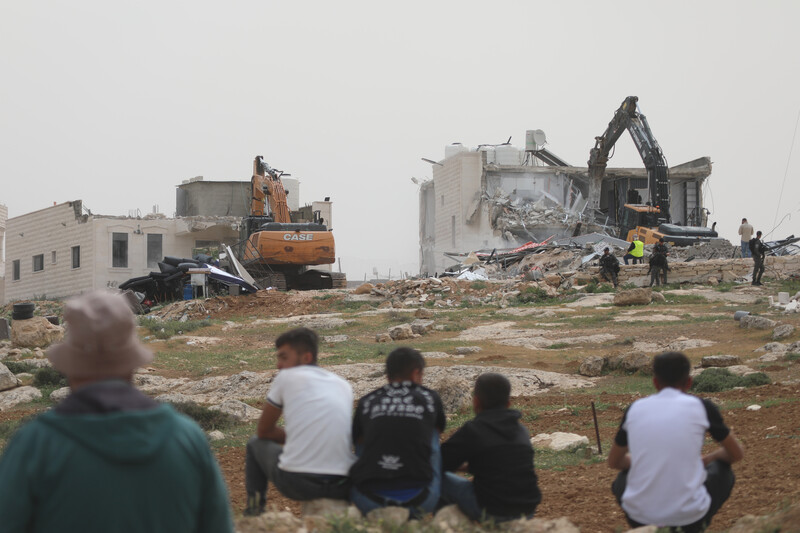
The Israeli military demolishes Palestinian homes under the pretext that they were constructed without a permit in the village of al-Samua, near Hebron in the southern West Bank, 8 April.
APA imagesAlso on 7 April, a group of independent UN human rights experts stated that “we are witnessing the destruction of Palestinian life.”
“if they are not killed by bombs or bullets, they slowly suffocate for lack of basic means of survival,” the experts added. “The only difference is the means and speed of death.”
That same day, the heads of several UN agencies stated that “we are witnessing acts of war in Gaza that show an utter disregard for human life.”
The senior UN officials urged “world leaders to act – firmly, urgently and decisively – to ensure the basic principles of international humanitarian law are upheld.”
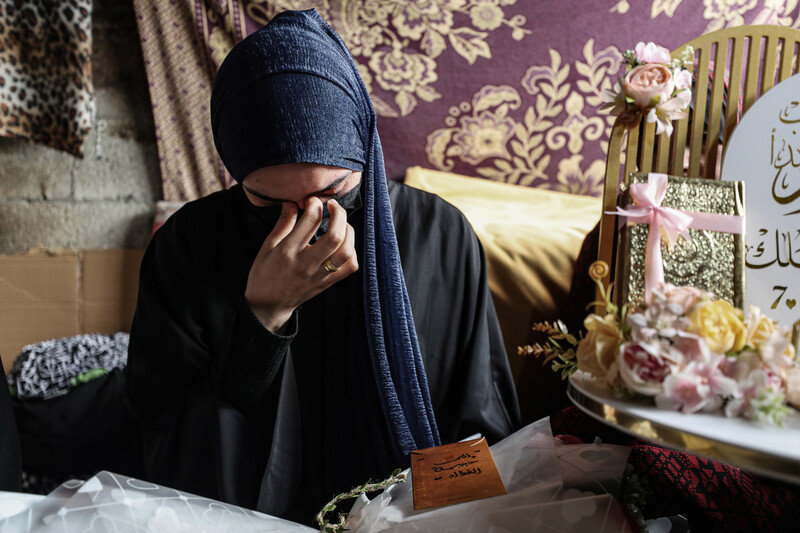
Malak Abu al-Umreen, 20, is displaced with her family at al-Dahyan school in the Sheikh Radwan neighborhood of Gaza City, 10 April. A university student, she had been looking forward to her wedding day on 8 April. But her joy turned into profound sorrow when her fiancé, Ahmad Ghrab, was killed in an Israeli airstrike in Deir al-Balah on 7 April that also claimed the lives of all his family members.
APA imagesOn 8 April, Israeli officials and occupation forces forcibly entered six UNRWA schools in East Jerusalem and issued closure orders “effective in 30 days,” the UN agency stated.
“Some 800 boys and girls are directly impacted by these closure orders and are likely to miss finishing their school year,” UNRWA added.
Noting that UNRWA schools are “protected by the privileges and immunities of the United Nations,” the agency added that the “illegal closure orders come in the wake of” legislation passed by Israel’s parliament seeking to shut down its operations.
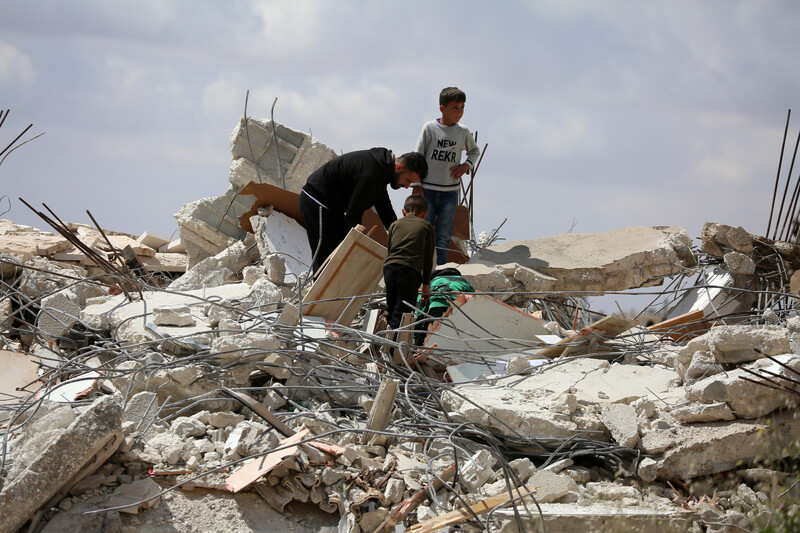
Palestinians salvage their belongings after the Israeli army demolished three homes and displaced about 30 people under the pretext of construction without a permit in the village of al-Rihiya near Hebron in the southern West Bank, 11 April.
ActiveStillsOn 8 April, António Guterres, the UN secretary-general, said that he opposed an Israeli proposal to control the delivery of humanitarian aid in Gaza.
Guterres asserted that the world body “will not participate in any arrangement that does not fully respect the humanitarian principles: humanity, impartiality, independence and neutrality.”
“With crossing points into Gaza shut and aid blockaded, security is in shambles and our capacity to deliver has been strangled,” Guterres added.
The Palestinian health ministry in Gaza said that at least 29 people were killed in an Israeli airstrike on a residential building in Shujaiya on the eastern outskirts of Gaza City on 9 April. Israel claimed to have hit a Hamas commander in the deadly strike.
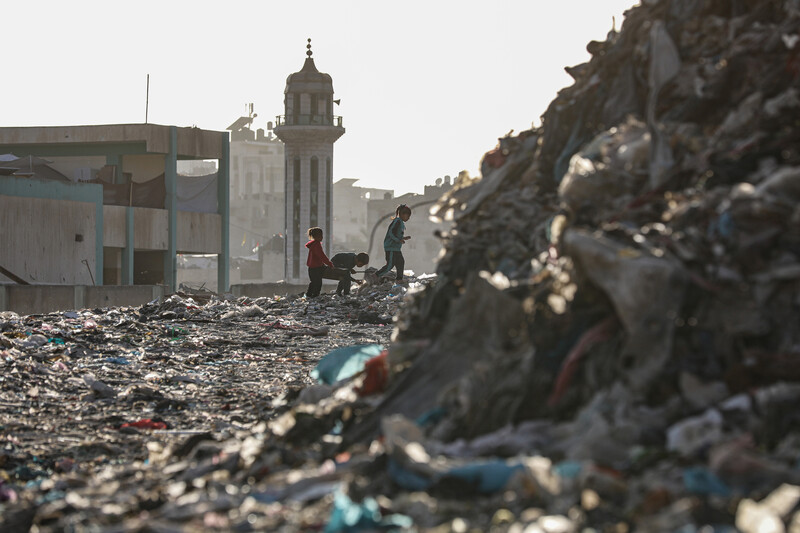
Children search for salvageable items in a garbage dump that sprawls across what used to be the Firas market in Gaza City, 11 April.
APA imagesOn 11 April, the UN human rights office warned that “Israel appears to be inflicting on Palestinians in Gaza conditions of life increasingly incompatible with their continued existence as a group.”
The UN office said that “the nature and scope” of evacuation orders displacing Palestinians in Gaza “raise serious concerns that Israel intends permanently to remove the civilian population from these areas in order to create a ‘buffer zone.’”
“Permanently displacing the civilian population within occupied territory amounts to forcible transfer, a grave breach of the Fourth Geneva Convention and a crime against humanity under the Rome Statute,” the UN human rights office added.

Damage at the Al Ahli Arab Hospital in Gaza City after an Israeli airstrike targeted one of the facility’s main buildings, 13 April.
ActiveStillsThe following day, 12 April, the Israeli military announced that it had encircled Rafah, the southernmost area of Gaza.
Ten days earlier, Netanyahu said that the military was seizing an area dubbed the Morag corridor located between Rafah and Khan Younis.
“Because we are now dividing the Strip and we are increasing pressure step by step so [Hamas] will give us our hostages,” Netanyahu claimed.
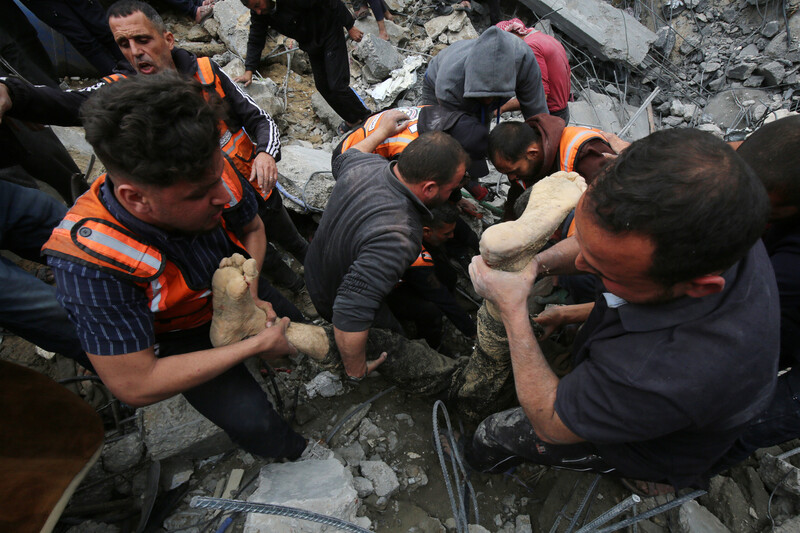
Civil defense workers and others conduct a search and rescue operation in a building targeted by the Israeli army in Jabaliya, northern Gaza Strip, on 13 April. Casualties and injuries were reported in the attack.
APA imagesOn 13 April, Tedros Adhanom Ghebreyesus, the head of the World Health Organization, announced that Al Ahli Arab Hospital was “out of service” after it was ordered evacuated and attacked earlier in the day.
“A child died due to disruption of care,” Ghebreyesus said, and the hospital’s “emergency room, laboratory, emergency room X-ray machines and the pharmacy were destroyed.”
Though Ghebreyesus did not name the attacking party – the Israeli military – he said that “patients, health workers and hospitals must be protected.”
Hamas rejected Israel’s claim that it was using the hospital as a command center and called for an international investigation.
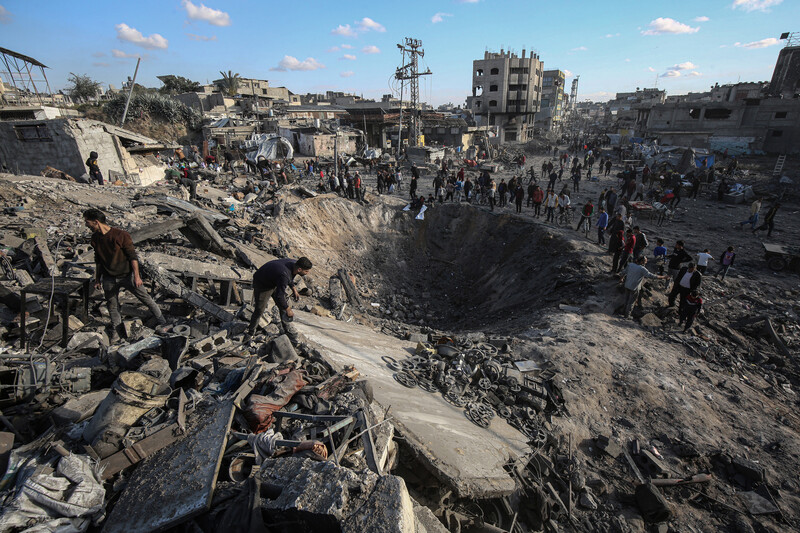
Palestinians gather around a large crater following an Israeli strike on a metalsmith workshop in the Zaytoun neighborhood of Gaza City, 13 April.
APA imagesThe Euro-Med Monitor, a human rights group based in Geneva, said that the hospital was given less than 30 minutes to evacuate “dozens of patients and wounded people – some in critical condition” before the attack.
“Patients were left lying on sidewalks, exposed to the risk of death and denied access to medical care, highlighting the severity of the escalating humanitarian crisis,” Euro-Med Monitor stated.
“Following the evacuation process, an injured child, Hatem al-Nabih, died outside the hospital,” the rights group added.
The Diocese of Jerusalem stated that it was “appalled at the bombing of the hospital,” which is run by the Anglican Church in Jerusalem. The diocese said that it was the fifth time that the hospital was attacked since October 2023, “and this time on the morning of Palm Sunday and the beginning of Holy Week.”
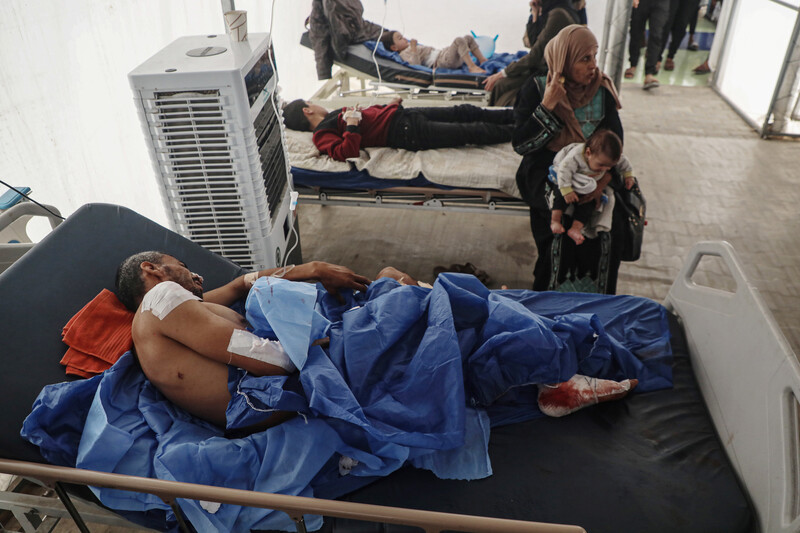
Wounded people receive treatment at a Kuwaiti Red Crescent field hospital in Gaza City after being transferred from Al Ahli Arab Hospital, which was targeted by Israeli war planes days earlier, 15 April.
APA imagesOn 13 April, the Israeli military announced that a missile launched from Yemen was likely intercepted. Ansarullah in Yemen claimed responsibility for what it said were two ballistic missiles aimed toward Ashdod in southern Israel and the international airport near Tel Aviv, setting off air raid sirens across the country.
On 15 April, Abu Obeida, the spokesperson for the armed wing of Hamas, said that the group had lost contact with the unit that was holding Edan Alexander, an American who enlisted in the Israeli military and who has been held captive in Gaza since 7 October 2023.
Abu Obeida said that the Israeli military “directly” bombed the area where Alexander was being held. He added that “it seems that the occupation army is deliberately trying to kill him and hence relieve themselves from the pressure caused by the dual-citizen prisoners in order to continue its genocide against our people.”
A few days earlier, Hamas released a video showing Alexander alive and pleading for Trump to secure his release.
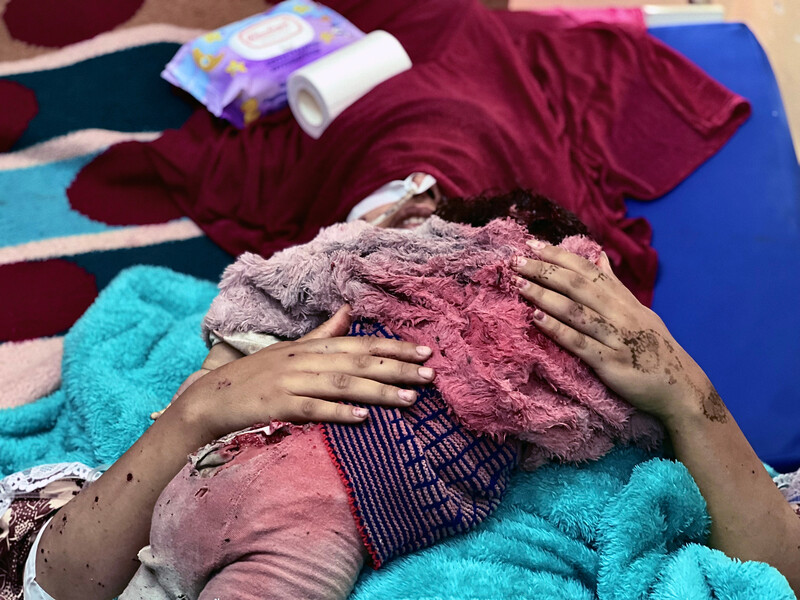
The injured mother of Ahlam Siyam, a 1-year-old girl who was killed in an Israeli airstrike the previous night, embraces her daughter’s body at Nasser Medical Complex in Khan Younis, southern Gaza, 16 April.
ActiveStillsAlso on 15 April, Netanyahu and Israel Katz, the Israeli defense minister, made an appearance in northern Gaza along with other senior officials, where Netanyahu reportedly received a security briefing and met with soldiers.
On 16 April, Katz said that Israeli troops would remain in Gaza’s so-called buffer zones even after an agreement is reached to end the war “as in Lebanon and Syria.”
The Israeli military claims to control 30 percent of the territory in Gaza – which was already one of the most densely populated places in the world before its residents were forcibly transferred to ever shrinking areas within the Strip.
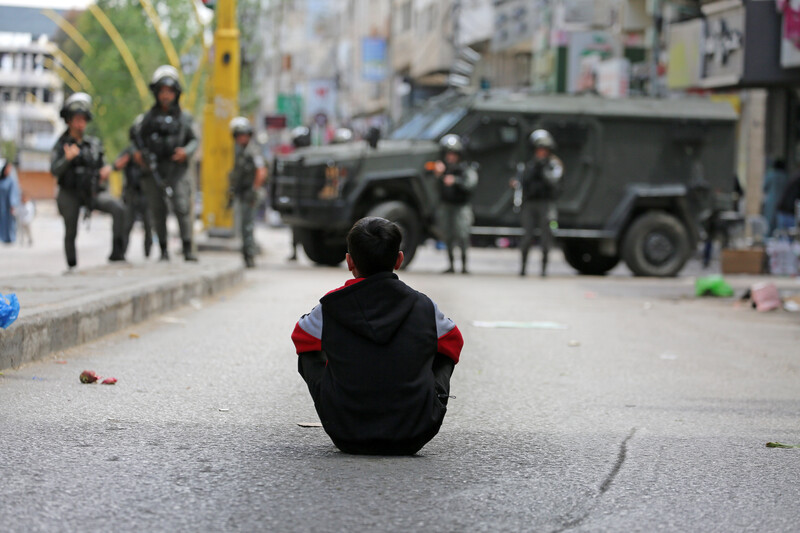
A Palestinian child faces Israeli soldiers as they storm the center of Hebron in the southern West Bank to guard settlers celebrating at an ancient tomb during the Passover holiday, 16 April.
ActiveStillsThe following day, Khalil al-Hayya, a senior Hamas official, said that the group would release all of the captives being held in Gaza as part of a comprehensive agreement to end the war. Such a deal would also see the release of Palestinian prisoners and the reconstruction of Gaza, al-Hayya said.
Two days later, Netanyahu announced that he had told the military to “further increase the pressure on Hamas.”
“We are in the War of Rebirth, the War on Seven Fronts,” Netanyahu said, referring to Gaza and the West Bank, Lebanon, Syria, Iraq, Yemen and Iran. The Israeli prime minister added that we “have no choice but to continue fighting for our very existence until victory.”
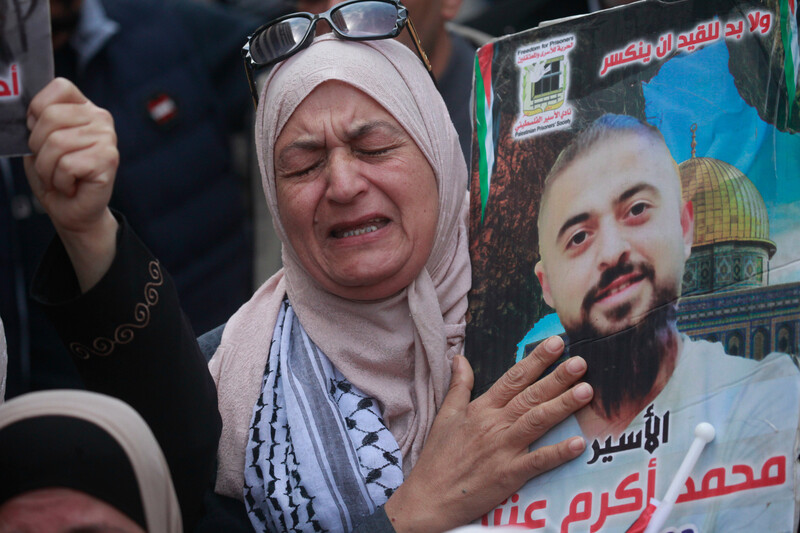
Protesters mark Palestinian Prisoners Day in the West Bank city Nablus on 16 April.
APA imagesHamas indicated its openness towards a long-term truce with Israel on 26 April but said that disarming was off of the table.
Later in the month, Ron Dermer, Israel’s strategic affairs minister, said that by this time next year, the “seven-front war” will have been won by Israel, to be followed by “many peace agreements” during the Trump presidency.
The Times of Israel said that Dermer’s comments marked “marked the first time a senior official has given a timeframe” for the war to be over.
“There are many countries that will want to make peace with Israel. But the key to that is victory,” Dermer said. “In the Middle East, when you win, when you’re strong, that’s what attracts others.”

A camp for displaced people inside a former Hamas military camp in Gaza City, 19 April. The site is littered with unexploded munitions left behind by the Israeli military; with no other options for shelter, Palestinian families are living there despite the significant threat to their lives.
ActiveStillsOn 16 April, journalist Fatima Hassouna was killed in an attack on a residential building in Khan Younis, two weeks after Muhammad Saleh al-Bardawi, a journalist with Voice of Al-Aqsa Radio, his wife and their three children were killed in a strike in the same neighborhood in Khan Younis.
Also on 16 April, a building belonging to the International Committee of the Red Cross in Gaza was damaged by an explosive, the humanitarian organization said. “This is the second such incident in three weeks; another premises in the area was struck by a tank shell on 24 March,” the ICRC said.
On 17 April, the heads of 12 major aid organizations made an “urgent plea” to “let us do our jobs” in Gaza, where “a staggering toll on civilians and aid workers, and now a six-week total siege” has left the humanitarian aid system on the brink of collapse.
“We have supplies ready. We have trained medical staff. We have the expertise. What we don’t have is the access – or the guarantee by Israeli authorities that our teams can safely do their jobs,” the aid agency chiefs said.
They added that Israel’s proposed new system for delivering aid in Gaza “would set a dangerous new global precedent and eliminate any remaining space to deliver aid independent of military and political motivations.”

Children gather near military remnants in the Jawazat area, which was used as the headquarters of the Palestinian police, west of Gaza City, 20 April.
APA imagesAlso during the month of April, the World Food Program reported that around 700,000 Palestinians in the West Bank “needed food assistance in 2024, a nearly 100 percent increase compared with the period before October 2023,” the UN Office for the Coordination of Humanitarian Affairs stated.
On 19 April, the Israeli military announced that one of its officers was killed by an explosive device in northern Gaza – the army’s first fatality since it resumed its offensive on Gaza a month earlier.
On 19 April, which marked Holy Saturday during Easter celebrations, Israeli forces erected dozens of temporary checkpoints in and around Jerusalem. Israeli forces assaulted worshippers attempting to access the Church of the Holy Sepulchre in Jerusalem’s Old City.
Only a limited number of Palestinians with West Bank IDs were granted permits by Israel were allowed to participate in Easter celebrations in Jerusalem.

A destroyed building that was hit by Israeli bombardment in Nuseirat refugee camp, central Gaza Strip, 20 April.
APA imagesOn 21 and 22 April, Israeli warplanes bombed three sites in Gaza where bulldozers were parked, destroying 36 heavy machines, including excavators, water trucks and sewer suction tanks. Nine of the destroyed machines were bulldozers brought into Gaza from Egypt after a ceasefire was declared in January.
Since the onset of Israel’s attacks in March, according to the Palestinian Center for Human Rights, the Israeli military has “systematically targeted civil defense vehicles, as well as many bulldozers and machinery belonging to municipalities and private companies.”
The destruction of this equipment will hinder the work of civil defense crews carrying out rescue and recovery operations in Gaza and “prevents the reopening of roads that have become blocked due to the destruction of buildings and houses,” the rights group said.
Hundreds of heavy machines are needed to recover “thousands of bodies trapped under the rubble,” PCHR added.
Many bodies have remained under the rubble of destroyed buildings following Israel’s attacks.
More than 900 bodies were recovered across Gaza between 19 January, when a now ended ceasefire took effect, and 8 April.
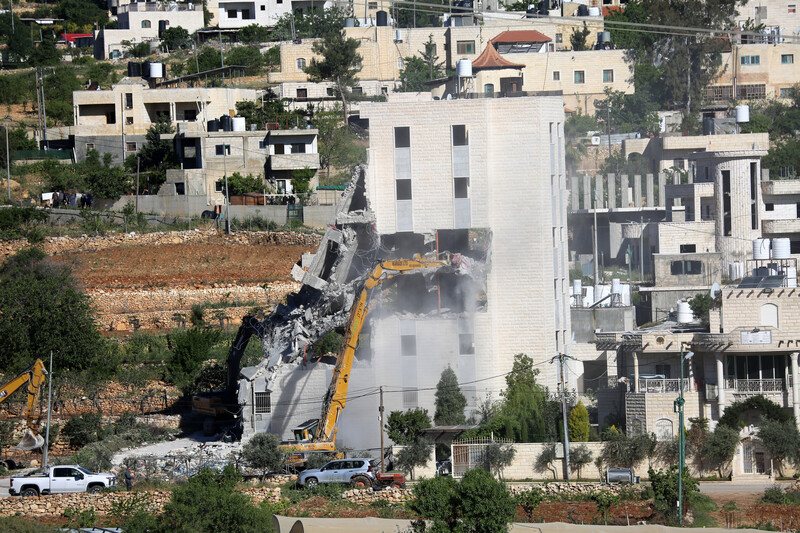
Israeli forces demolish a seven-story building in the village of Beit Ummar, near the southern West Bank city of Hebron, under the pretext that it was built without a permit, 21 April. The property is directly across from Karmei Tzur settlement that was built on Palestinian land.
ActiveStillsThe Israeli attacks on 22 April were among the heaviest carried out in Gaza since 18 March.
A staff worker was killed when the gate to the Kuwaiti Field Hospital in Khan Younis was hit on 22 April, according to the UN Office for the Coordination of Humanitarian Affairs.
Meanwhile, the Palestinian health ministry in Gaza said that a polio vaccination campaign supported by the UN \scheduled to take place in early April had been suspended as Israel continues to block the entry of commercial goods, aid and medicines into the territory.
On 23 April, Ansarullah in Yemen said that it had launched a missile towards Israel. The latter claimed to have intercepted the projectile.
Three days later, the Israeli military said that it intercepted another missile fired from Yemen. Ansarullah said that the projectile was aimed towards Israel’s Nevatim air base.
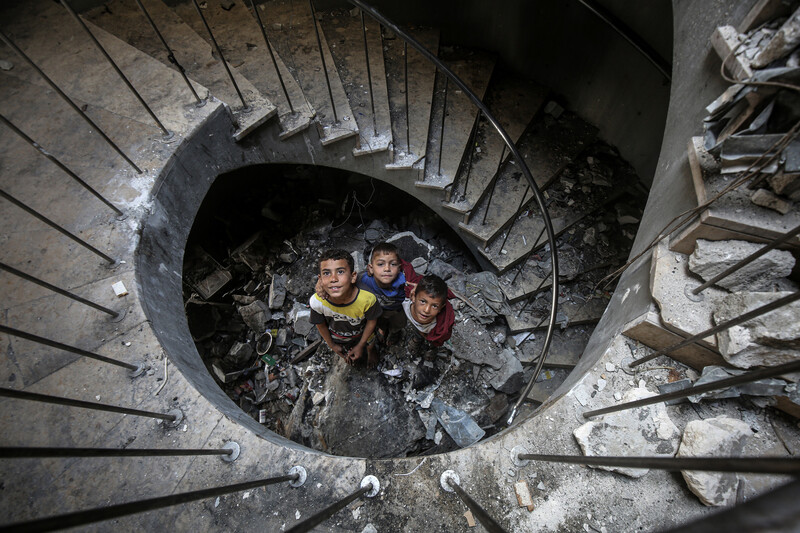
Children pose inside the destroyed Rashad al-Shawa Cultural Center in Gaza City, which is being used a shelter for displaced families, 22 April.
APA imagesAlso on 23 April, 10 people were killed in an Israeli airstrike on a school where displaced families were sheltering in Gaza City.
At least 26 people were killed in Israeli attacks across Gaza over the previous 24 hours, the health ministry said on 23 April. An Israeli missile hit the Dura Children’s Hospital in Gaza City that same day, according to the ministry, destroying the facility’s solar panel system and rendering it non-operational.
With the pediatric hospital forced to close, “there are now 22 hospitals that are partially functional in Gaza,” according to OCHA. These include four in north Gaza, 11 in the Gaza City area, three in Deir al-Balah in central Gaza, four in Khan Younis in the south and “none in Rafah.”
In the West Bank, settlers attacked Palestinians and their property in Sinjil village near Ramallah in the West Bank, injuring eight people, on 23 April. Two days earlier, around 200 settlers burned three homes in the village and stole residents’ sheep, “prompting confrontations with residents attempting to defend their properties,” the UN human rights office said.
Between 23 and 24 April, the UN office added, “Israeli settlers reportedly injured seven Palestinians with live ammunition and set fire to residential tents and livestock shelters” in Bardala village in the West Bank’s Jordan Valley.
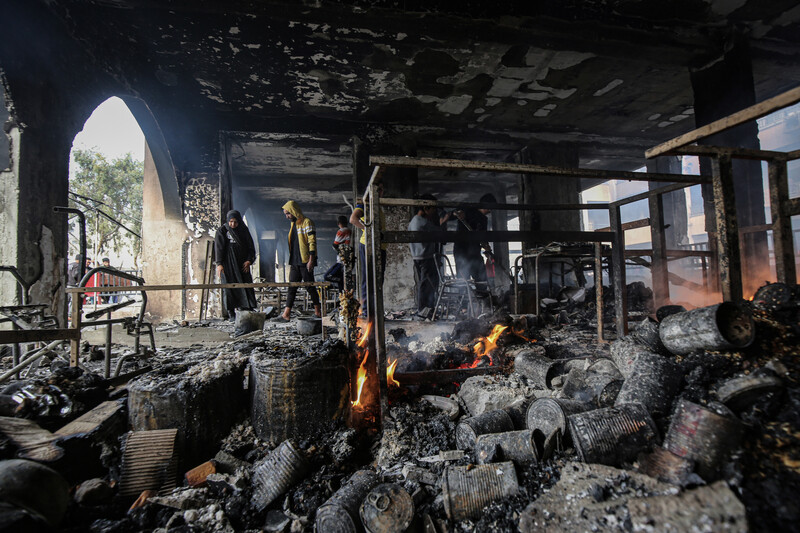
Palestinians inspect the damage after an Israeli strike on a school housing displaced people in Gaza City, 23 April.
APA imagesOn 24 April, at least 10 people were killed and dozens of others were wounded in an Israeli airstrike on a police station in Jabaliya, northern Gaza. An Israeli soldier was killed by sniper fire in northern Gaza that same day.
Two Israeli officers were killed in the Shujaiya area of Gaza City on 25 April.
That same day, the World Food Program said that it had run out of food stocks after nearly two months of total closure of Gaza’s crossings.
The UN food agency added that it had “delivered its last remaining food stocks to hot meals kitchens in the Gaza Strip.”
These kitchens, “the only consistent source of food assistance” in Gaza, are expected to run out of food “in the coming days,” the World Food Program said. Bakeries supported by the organization closed at the end of March.
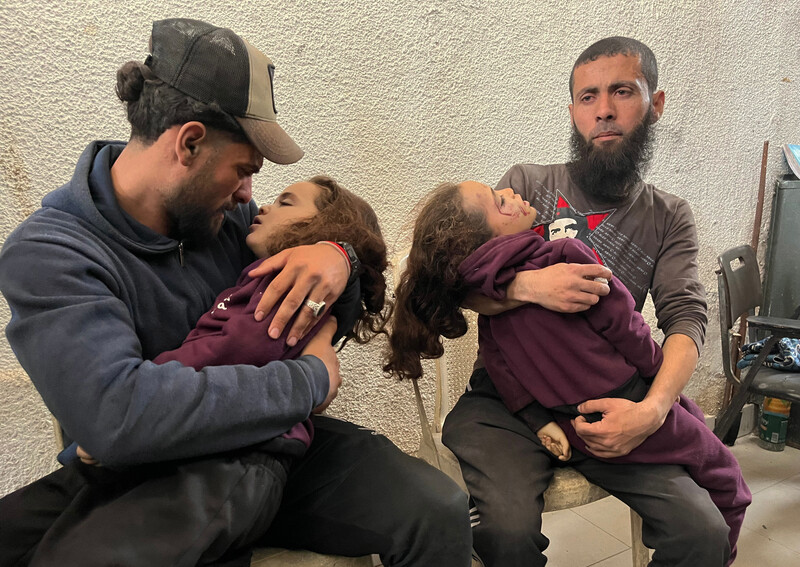
Relatives mourn twin girls from the Abu Saif family who were killed in an Israeli strike on a school being used as a shelter, Al-Shifa Hospital in Gaza City, 23 April.
APA imagesThe UN food agency said that food prices had spiked by 1,400 percent compared to during the ceasefire and that more than 116,000 tons of food aid – “enough to feed one million people for up to four months” – was sitting at the closed crossing.
Also on 25 April, Donald Trump, the US president, told reporters that he had pressed Netanyahu on opening Gaza’s crossings during a phone call earlier in the week. “Gaza came up and I said, ‘We’ve got to be good to Gaza … Those people are suffering,’” Trump recounted.
That same day, the health ministry in Gaza said that at least 78 people were killed in Israeli attacks across the territory in the previous 24 hours.
The UN human rights office said that “since the collapse of the ceasefire, and during the past week in particular, Israeli attacks on Palestinians have accelerated, claiming the lives of countless civilians and further risking the complete destruction of what little infrastructure remains.”
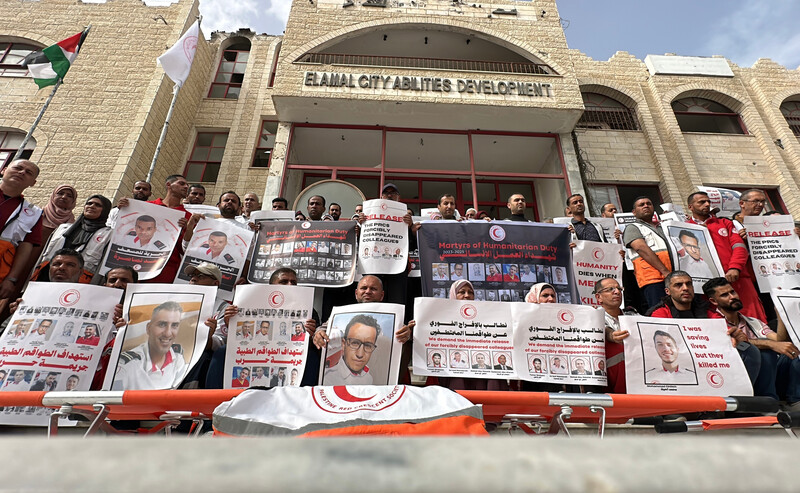
Palestine Red Crescent Society employees participate in a solidarity vigil in Khan Younis, southern Gaza, to demand an international investigation and justice for the execution of 15 emergency workers by the Israeli military the previous month, 23 April.
APA imagesMeanwhile in the West Bank, the UN office added, “rampant settler violence and operations conducted by Israeli security forces in the West Bank are continuing to kill or injure Palestinians and are resulting in the forced displacement of Palestinians from their homes or shelters in many areas.”
Bezalel Smotrich, Israel’s far-right finance minister, has declared 2025 to be the “year of sovereignty” in the West Bank, where settler violence has surged by 30 percent compared to last year.
Israeli authorities approved more than 14,000 housing units in the West Bank in the first quarter of 2025 – nearly 50 percent more than the total number approved during all of last year.
In a situation report published on 24 April, the UN Office for the Coordination of Humanitarian Affairs stated that “displacement in the West Bank is on the rise.”
Over the previous week, OCHA said, “Israeli forces ordered 14 families to leave their homes in Tulkarm city, while continuing to prevent tens of thousands of previously displaced people from returning to their homes in refugee camps in Jenin and Tulkarm.”
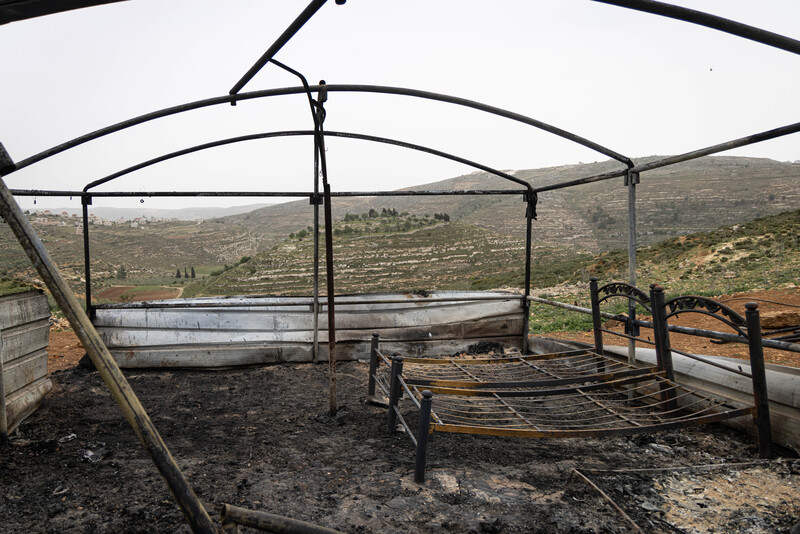
The aftermath of a settler attack days earlier on the outskirts of Sinjil, a village near the central West Bank city of Ramallah, 23 April. The assault involved more than 100 settlers, accompanied by soldiers, following the establishment of a new settlement outpost that same day.
ActiveStillsThe UN human rights office noted that between 18 March and 22 April, it had recorded nearly 230 attacks on residential buildings and more than 90 attacks on tents sheltering displaced people in Gaza. Most of these attacks resulted in fatalities, “including many children and women,” the UN office added.
“Airstrikes on tents in Gaza reportedly killed 15 children, including a child with disabilities who burned to death,” Catherine Russell, the head of the UN children’s fund UNICEF said on 27 April. “Images of children burning while sheltering in makeshift tents should shake us all to our core.”
On 28 April, Euro-Med Monitor stated that over the previous few weeks, it had “documented repeated instances of entire families being wiped out, as well as the deliberate targeting of specific families in a pattern suggesting a clear intent to annihilate them.”
Meanwhile, the Israeli military is using drones “equipped with advanced surveillance cameras and guidance systems” to target tents and homes sheltering displaced people in Gaza.
A drone was used to target a tent in the al-Mawasi area of Khan Younis on 25 April, killing Ibrahim and Hanadi Abu Taima and their three young children, according to Euro-Med Monitor.
“Israeli massacres against Palestinians have become a familiar sight, met with near-total silence despite the genocide essentially being livestreamed across the globe,” the rights group said.
“It’s as if the killing of Palestinian civilians – openly committed by Israel and its allies without fear of legal or moral consequences – has become an implicitly accepted reality within the international system,” Euro-Med Monitor added.

Palestinians inspect a damaged building following an Israeli airstrike in Gaza City on 24 April.
APA imagesOn 26 April, Israel’s public broadcaster Kan reported that the army was establishing a new “humanitarian zone” in Rafah, the southernmost area of Gaza.
Residents told Reuters that the military is flattening remaining structures in the city of Rafah “in what they fear is a part of a plan to herd the population into confinement in a giant camp on the barren ground.”
On 28 April, the International Court of Justice, also known as the World Court, opened hearings about Israel’s legal obligations to allow and facilitate humanitarian aid. The UN General Assembly passed a resolution requesting an advisory opinion on the matter last December.
The court, based in The Hague, is also considering a genocide complaint brought against Israel by South Africa. Last year, the tribunal issued an advisory opinion declaring Israel’s continuing presence in the West Bank and Gaza to be unlawful and urged states to end the illegal occupation.
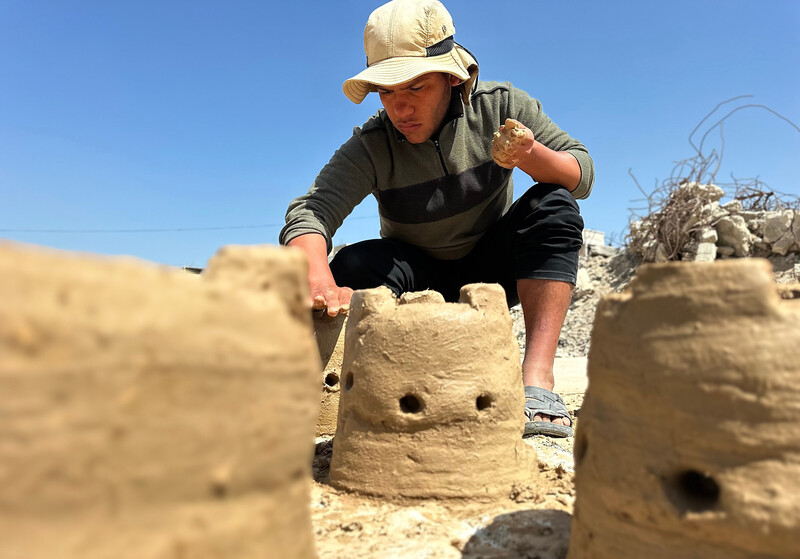
Clay ovens are manufactured for cooking due to the lack of cooking gas, Khan Younis, southern Gaza Strip, 24 ِApril.
APA imagesOn 29 April, the Palestine Red Crescent Society stated that Israel had freed Asad al-Nasasrah, a medic who had been missing after 15 paramedics, rescue workers and a UN employee were killed and buried in a shallow grave by Israeli troops in southern Gaza last month.
Earlier in the month, Younis al-Khatib, the chairperson of the Palestine Red Crescent Society, called for “proper accountability and a stop to impunity” after the Israeli military admitted to “professional failures.”
Also on 29 April, António Guterres, the UN secretary-general, urged states to “take irreversible action towards implementing a two-state solution” before an international conference hosted by France and Saudi Arabia in June.
Jean-Noel Barrot, the French foreign minister, said that “our objective is clear: to make progress on the recognition of Palestine and the normalization of relations with Israel at the same time.”
That same day, Volker Türk, the UN human rights chief, called for “concerted international efforts” to stop the humanitarian catastrophe in Gaza “from reaching a new unseen level.”
Regarding the Israeli military’s genocidal conduct in Gaza, Türk said that third states are obligated to “ensure that such conduct stops immediately.”
He added that “they also must search for and bring to justice all perpetrators of crimes under international law, by whomever committed.”
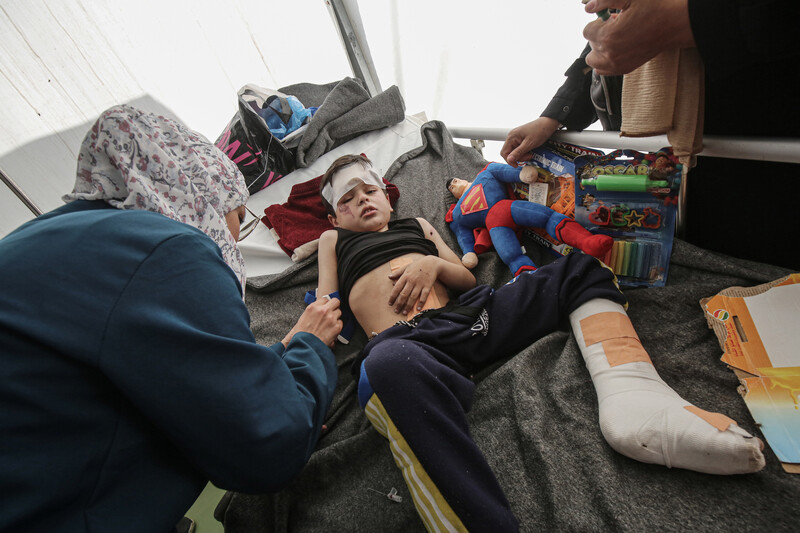
Ali Faraj, 7, is treated at the Kuwaiti Field Hospital in Gaza City on 25 April. The boy and his mother were the sole survivors of an Israeli strike that killed the rest of their family, including Ali’s father and five sisters and multiple members of his extended family.
APA imagesOn 1 May, Tom Fletcher, the UN humanitarian chief, issued an appeal for Israel to lift the “brutal blockade” on Gaza and “let humanitarians save lives.”
“To the civilians left unprotected, no apology can suffice,” he added.
“But I am truly sorry that we are unable to move the international community to prevent this injustice,” Fletcher said.
“We won’t give up, even if the world has given you every reason to give up on us.”
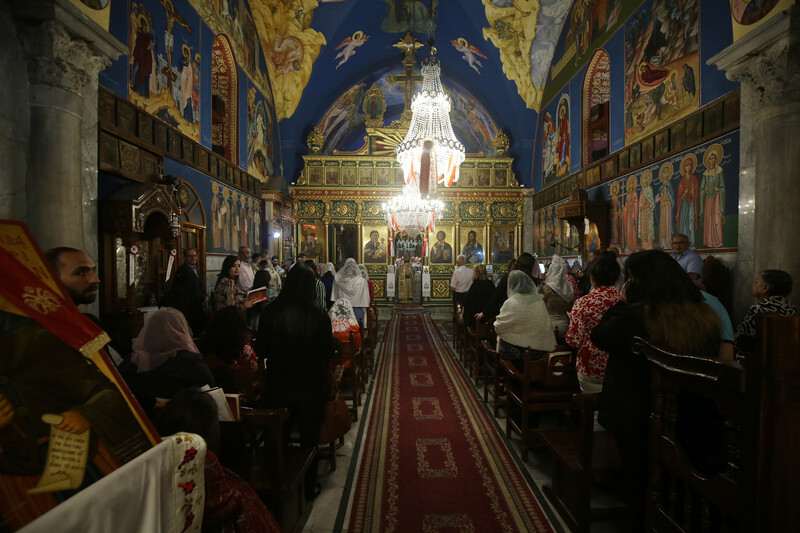
Christians attend Easter Mass at St. Porphyrius Church in Gaza City as the Israeli army continues its attacks on the Gaza Strip, 20 April.
APA imagesAmong the Palestinians killed in the West Bank during April was a man who was shot after a raid on his house in the Old City of Nablus, during which his brother was arrested, according to OCHA.
That same day, 2 April, Israeli troops shot and killed Omar Amer Zyoud, a 16-year-old who was reportedly among a group that threw incendiary objects at military jeeps at the entrance to Silat al-Harithiya village near Jenin in the northern West Bank.
Israeli troops shot and killed a Palestinian man after he allegedly threw stones at Israeli vehicles in the Bethlehem area of the southern West Bank on 3 April and confiscated his body.
A man was killed by Israeli troops searching his house when they shot at him while he was attempting to flee in his vehicle in Jenin on 4 April.
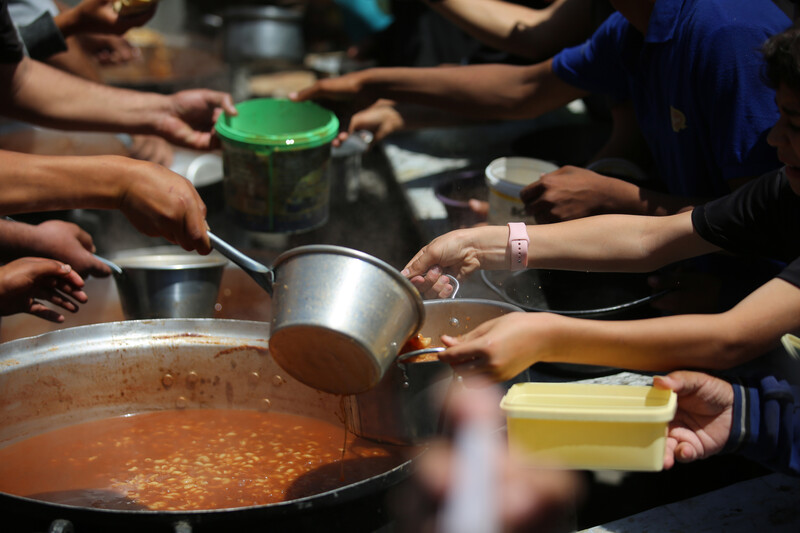
Palestinians, mostly children, receive a warm meal distributed by charitable organizations in Nuseirat refugee camp in central Gaza, 26 April.
APA imagesOn 6 April, Israeli forces shot and killed Amer Rabee, a 14-year-old Palestinian American, at the entrance to Turmusayya, a town north of Ramallah in the central West Bank.
The Israeli military claimed it had opened fire toward “terrorists” who had “hurled rocks” towards a highway.
According to Defense for Children International-Palestine, Amer and two other children “were picking green almonds on the agricultural land adjacent to Route 60, when Israeli soldiers started shooting at the children from a distance of about 20 meters (66 feet) away.”
“Amer was shot in the head and immediately collapsed,” the rights group added.
DCIP said that Israeli forces withheld the boy’s body, which was found to have sustained 13 bullet wounds, for around five hours. “It remains unclear if these additional shots were fired before or after his body was detained,” the group added.
Israeli forces fired some 46 bullets towards the three children; the two who survived “were shot a total of four times and sustained injuries to their stomachs and genitals,” according to DCIP.
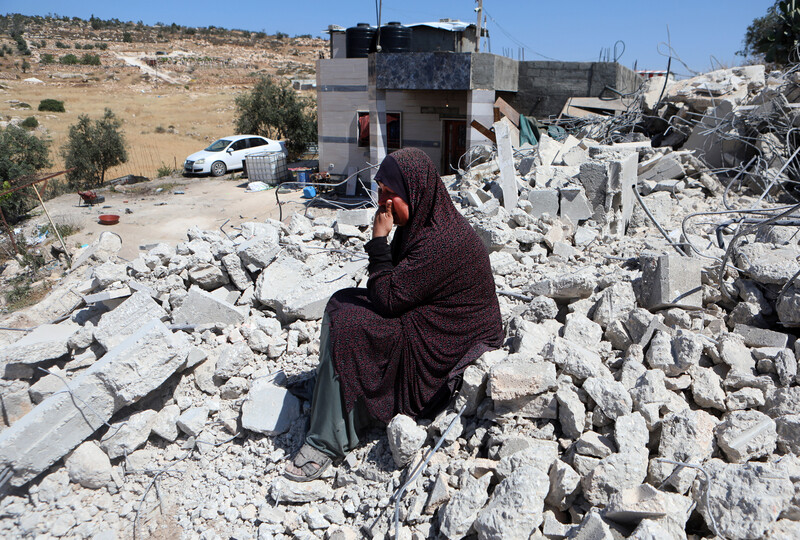
A woman cries while sitting on the ruins of a building destroyed by the Israeli military in Idhna village, near Hebron in the southern West Bank, 28 April.
APA imagesA woman from Bidya, a village near Salfit in the central West Bank, was shot and killed by Israeli forces on 8 April after she allegedly threw stones and approached troops with a knife near Ariel settlement, according to OCHA.
On 14 April, Israeli forces shot Malik al-Hattab, 16, in the stomach during an incursion into Jalazone refugee camp near Ramallah. The boy died after nearly 20 hours in intensive care, according to Defense for Children International-Palestine, which said that the boy’s severe internal injuries were likely caused by expanding bullets.
These weapons have been prohibited under international law since 1868, according to Ayed Abu Eqtaish, a program director with the rights group, “due to the extreme and unnecessary suffering they cause.”
“Yet, Israeli forces use these illegal weapons against Palestinian children with no consequences from the international community,” Eqtaish added.
At least five children have been killed by expanding bullets in the West Bank since 7 October 2023, according to DCIP.
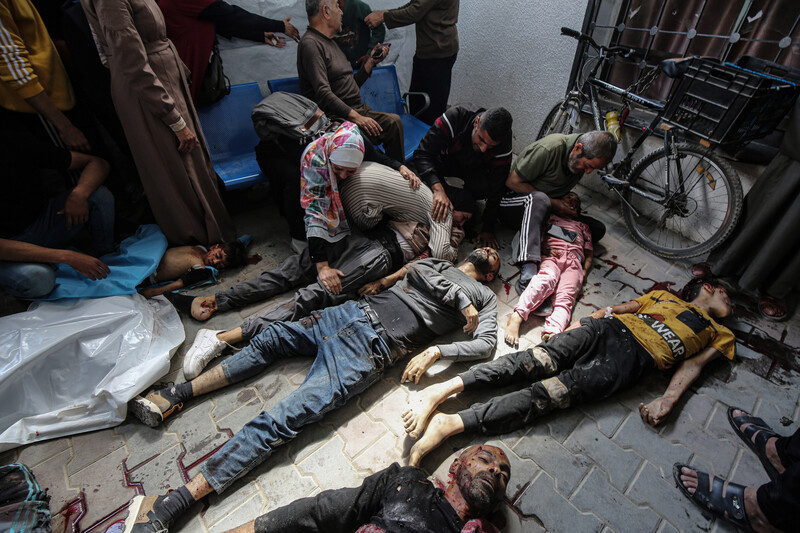
Relatives mourn over the bodies of their loved ones killed in Israeli attacks at Al-Shifa Hospital in Gaza City, 27 April.
APA imagesIsraeli forces killed six Palestinians, including a child, in the West Bank between 15 and 21 April. Two Palestinians from the territory died in Israeli custody in unclear circumstances during the same period, according to OCHA.
Israeli forces shot and killed two Palestinians with whom they exchanged fire outside of Qabatiya village near Jenin on 16 April. Israel is withholding the bodies of the two slain individuals.
On 17 April, Israeli forces shot and killed two Palestinians, including Jihad Adeli, 16, who were reportedly throwing stones at Israeli vehicles near Osarin, a village near Nablus in the northern West Bank. Israel is withholding their bodies.
According to OCHA, the deadly incident “followed the announcement of the death of a Palestinian from the village in Israeli custody … three days before he was set to be released.”
Defense for Children International-Palestine stated that Jihad Adeli was part of a group that was ambushed by troops.
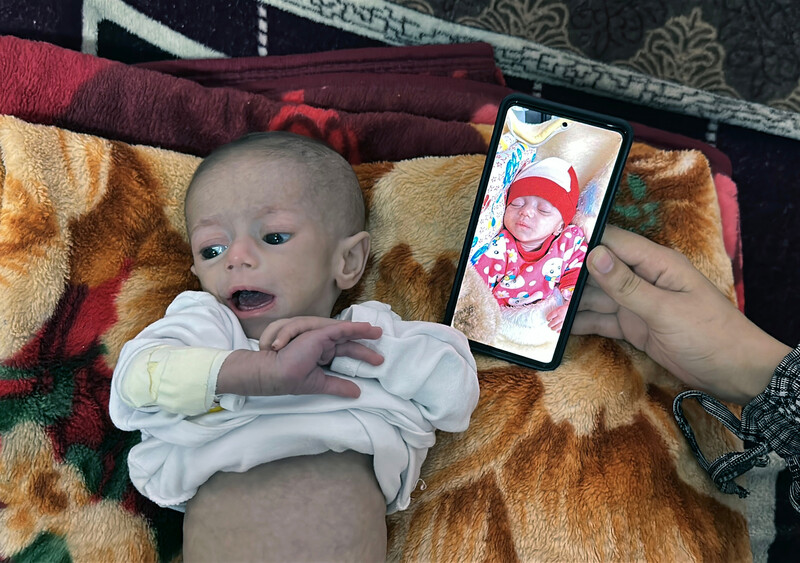
Five-month-old Siwar Ashour receives medical care for severe malnutrition at Nasser Medical Complex in Khan Younis, southern Gaza Strip, on 30 April.
APA imagesOn 20 April, Israeli forces shot and killed a Palestinian near Homesh settlement in the northern West Bank after the man reportedly opened fire towards a checkpoint near the settlement, causing no casualties.
On 23 April, Israeli forces shot and killed Mahmoud al-Haija, 12, in a cemetery in al-Yamoun, a town near Jenin in the northern West Bank.
“Mahmoud, alongside other boys and young men, were allegedly throwing stones toward Israeli soldiers deployed around the cemetery while other soldiers raided a residential building nearby,” Defense for Children International-Palestine said in an initial report.
On 25 April, Israeli soldiers hiding behind a tree shot and killed Abdulkhaleq Jabour, 16, while he was closing up the shop where he worked during a military incursion into Salem, a town east of Nablus.
According to Defense for Children International-Palestine, Israeli soldiers surrounded Abdulkhaleq for at least 10 minutes while two of his relatives attempted to render first aid.
Israeli forces have killed 24 Palestinian boys and girls in the West Bank since the beginning of the year, according to the children’s rights group.

Gaza City during a dust storm on 30 April.
APA imagesIn addition to the above, on 21 April, a 48-year-old man died of a heart attack triggered by tear gas inhalation after he was assaulted by Israeli forces who accompanied settlers during a raid in the town of Sinjil near the West Bank city of Ramallah.
“During the incident, Israeli forces injured 17 other Palestinians, including four children, and Israeli settlers physically assaulted and injured three Palestinians,” according to OCHA.
And on 27 April, a man from a village near Nablus fell to his death while attempting to jump over Israel’s wall near al-Ram, a town near Jerusalem. Israeli forces fired tear gas and rubber bullets towards the group of Palestinians who were attempting to search for work.
OCHA said that it has documented the killing of 10 Palestinians by live ammunition fired by Israeli forces while they were trying to cross the wall amid rising unemployment in the West Bank.


